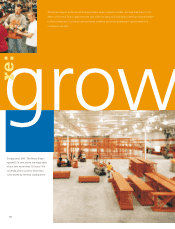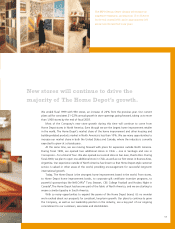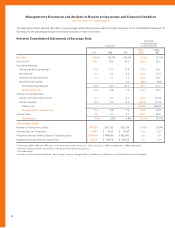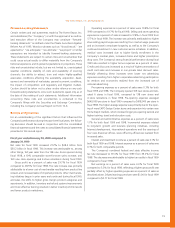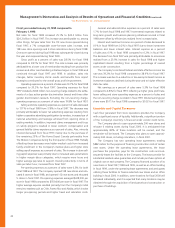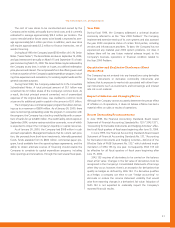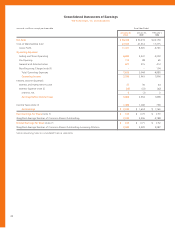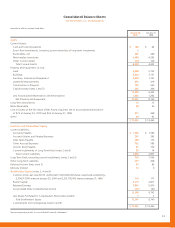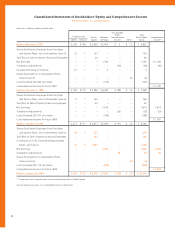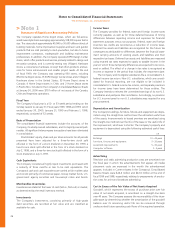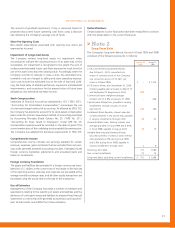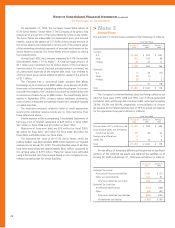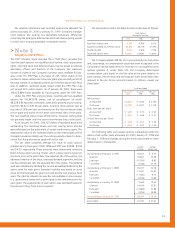Home Depot 1999 Annual Report Download - page 25
Download and view the complete annual report
Please find page 25 of the 1999 Home Depot annual report below. You can navigate through the pages in the report by either clicking on the pages listed below, or by using the keyword search tool below to find specific information within the annual report.
The Home Depot, Inc. and Subsidiaries
The cost of new stores to be constructed and owned by the
Company varies widely, principally due to land costs, and is currently
estimated to average approximately $13.2 million per location. The
cost to remodel and/or fixture stores to be leased is expected to aver-
age approximately $4.3 million per store. In addition, each new store
will require approximately $3.2 million to finance inventories, net of
vendor financing.
During fiscal 1999, the Company issued $500 million of 61⁄2% Senior
Notes (“Senior Notes”). The Senior Notes are due on September 15, 2004,
and pay interest semi-annually on March 15 and September 15 of each
year commencing March 15, 2000. The Senior Notes may be redeemed by
the Company at any time, in whole or in part, at a defined redemption
price plus accrued interest. The net proceeds from the offering were used
to finance a portion of the Company’s capital expenditure program, includ-
ing store expansions and renovations, for working capital needs and for
general corporate purposes.
During fiscal 1999, the Company redeemed its 31⁄4% Convertible
Subordinated Notes. A total principal amount of $1.1 billion was
converted into 72 million shares of the Company’s common stock. As
a result, the total principal amount converted, net of unamortized
expenses of the original debt issue, was credited to common stock
at par and to additional paid-in capital in the amount of $1.1 billion.
The Company has a commercial paper program that allows borrow-
ings up to a maximum of $800 million. As of January 30, 2000, there
were no borrowings outstanding under the program. In connection with
the program, the Company has a back-up credit facility with a consor-
tium of banks for up to $800 million. The credit facility, which expires in
September 2004, contains various restrictive covenants, none of which
is expected to impact the Company’s liquidity or capital resources.
As of January 30, 2000, the Company had $168 million in cash
and cash equivalents. Management believes that its current cash posi-
tion, the proceeds from short-term investments, internally generated
funds, funds available from its $800 million commercial paper pro-
gram, funds available from the operating lease agreements, and the
ability to obtain alternate sources of financing should enable the
Company to complete its capital expenditure programs, including
store openings and renovations, through the next several fiscal years.
Year 2000
During fiscal 1999, the Company addressed a universal situation
commonly referred to as the “Year 2000 Problem.” The Company
implemented extensive testing of its own systems and also assessed
the year 2000 compliance status of certain third parties, including
vendors and infrastructure providers. To date, the Company has not
experienced any material year 2000 system problems, nor does it
believe there will be any future material adverse impact to the
Company’s business, operations or financial condition related to
the Year 2000 Problem.
Quantitative and Qualitative Disclosures About
Market Risk
The Company has not entered into any transactions using derivative
financial instruments or derivative commodity instruments and
believes that its exposure to market risk associated with other finan-
cial instruments (such as investments and borrowings) and interest
rate risk is not material.
Impact of Inflation and Changing Prices
Although the Company cannot accurately determine the precise effect
of inflation on its operations, it does not believe inflation has had a
material effect on sales or results of operations.
Recent Accounting Pronouncements
In June 1998, the Financial Accounting Standards Board issued
Statement of Financial Accounting Standards No. 133 (“SFAS 133”),
“Accounting for Derivative Instruments and Hedging Activities,” effec-
tive for all fiscal quarters of fiscal years beginning after June 15, 1999.
In June 1999, the Financial Accounting Standards Board issued
Statement of Financial Accounting Standards No. 137, “Accounting
for Derivative Instruments and Hedging Activities – Deferral of the
Effective Date of FASB Statement No. 133,” which deferred imple-
mentation of SFAS 133 by one year. Consequently, SFAS 133 will
be effective for all fiscal quarters of fiscal years beginning after
June 15, 2000.
SFAS 133 requires all derivatives to be carried on the balance
sheet at fair value. Changes in the fair value of derivatives must be
recognized in the Company’s Consolidated Statements of Earnings
when they occur; however, there is an exception for derivatives that
qualify as hedges as defined by SFAS 133. If a derivative qualifies
as a hedge, a company can elect to use “hedge accounting” to
eliminate or reduce the income statement volatility that would
arise from reporting changes in a derivative’s fair value. Adoption of
SFAS 133 is not expected to materially impact the Company’s
reported financial results.
21







